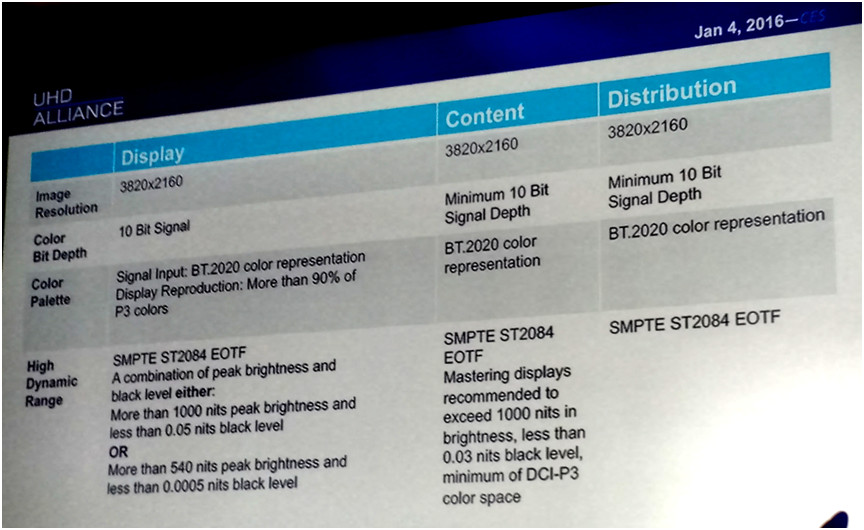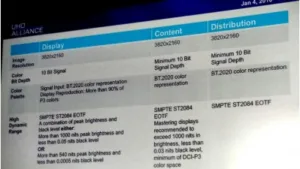I spent almost the entire time at CES looking at the High Dynamic Range (HDR) and Wide Color Gamut (WCG) ecosystem. One tutorial white paper on these technologies, along with a table of current and announced UHD TVs with these features, has just been published. A second report with the news on the HDR/WCG value chain will be ready next week. I am not done yet, but some conclusions are already clear. Here is what the industry seems to saying.

Nearly every UHD TV in 2016 will support some the basic HDR-10 level of HDR. Most will have HDMI 2.0a connectors to be able to read static metadata, which is part of HDR-10. That’s not so hard to do as it means extracting some information from the video stream. What the TV does with this static metadata will vary greatly based upon the capabilities of the TV and the sophistication of the processing.
Other 4K TVs will support more advancde levels of HDR such as the approaches proposed by Dolby, Technicolor & Philips and the BBC/NKH. Dolby takes the early lead here with a number of TVs announced that will support Dolby Vision. But Technicolor and Philips are merging their approaches and our discussion with the SoC providers suggests that the merged approach will also be added to silicon quite quickly in 2016. These silicon solutions will go in TVs, set top boxes, Blu-ray players and more – all planned for 2016.
The UHD Alliance had big news at CES announcing their definitions of Ultra HD Premium TVs, content and distribution – along with a certification program. As expected, there are two sets of different luminance levels for LCD and OLED. LCD TVs with 1000 nits and black levels of 0.05 nits or OLEDs with peak luminance of 540 nits and an ultralow 0.0005 nit black level can qualify for certification. Each must encode color in a BT 2020 container, but are only required to meet a 90% of DCI-P3 color gamut bar. That’s fairly low and was done to allow sets using RG Phosphor and/or filter technology to be able to be UHDA certified. A number of these sets and new content will be certified by the Alliance.

What about legacy SDR content? We heard of many companies who say they will now offer solutions for SDR-to-HDR conversion that can be done in real time and automatically. People will start to call this “faux” or “fake” HDR, I am sure. But the demos I saw looked pretty good. All will admit this is not as good as native HDR, but the algorithms have been developed by studying how colorists grade the HDR and SDR versions of content, and a large proporting of the changes are predictable, so implementable as algorithms.
Content creators may not be too happy that consumers can change their preciously mastered content, but they do that now anyway. It is analogous to 2D-to-3D conversion, but seems to perform much better.
There are also a number of ways to achieve a wide color gamut and most sets in 2016 look like they will reach the 90% of DCI-P3 bar. But quantum dot technology is clearly the front runner for achieving the high color gamuts – even if most content won’t be mastered in 2020 but rather in the P3 color gamut.
Film-based QD solutions have been expensive so far, but this will come down to enable mainstream TV products, probably in 2017, however. Edge-lit TVs will also get a boost as quantum dots for these TVs will get some help with HDR processing from Sigma Designs and Dolby to support this architecture.
HDR/WCG processing will also vary by device, as displays with various levels of white and black levels and color capabilities will exist. That means dozens of ways to potentially perform tone-mapping and stretch or compress the color gamut to fit the capabilities of the TV. As a result, any piece of content may look very different if played on 5 different TVs. That’s probably going to be the case for the next several years at least.
We also saw a great milestone at CES with the first public demo of a live UHD/HDR/WCG transmission using the ATSC 3.0 protocol. This is a powerful new over-the-air standard based on Internet Protocol that gives broadcasters wonderful new transmission flexibility and business opportunities. The last components of this standard should be approved soon with trial broadcasting to start within the month. The FCC will have to approve it, but the broadcasters, “just want the FCC to get out of their way.”
Ultra HD Blu-ray players were formally announced by Philips, Samsung and Panasonic with the first ones now ready for pre-order at $399. Hollywood says there should be over 100 UHD Blu-ray titles by the end of the year, with lots mastered in HDR/WCG too. Many of these titles will clearly be accessed over-the-top as well. Amazon and Vudu are doing this now for 4K/HDR/WCG content and Netflix, YouTube and others will jump in soon.
The Vidity platform is also coming in 2016. This is a hard disc-based device with lots of security and encryption that allows consumers to download the latest Hollywood 4K content and playback on the TV. Such services are available today at very high price points from companies like Prima and Kaleidescape, so look for much more affordable options here.
And there is so much more to say in the 60+ page report. Stay tuned for the link.

